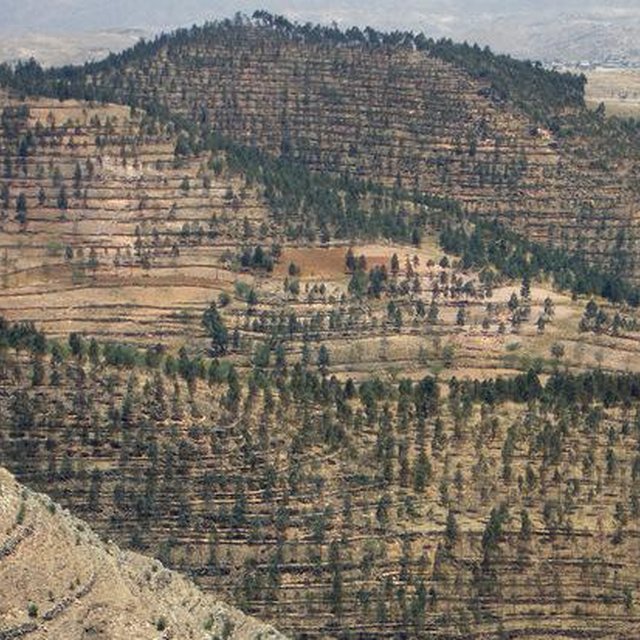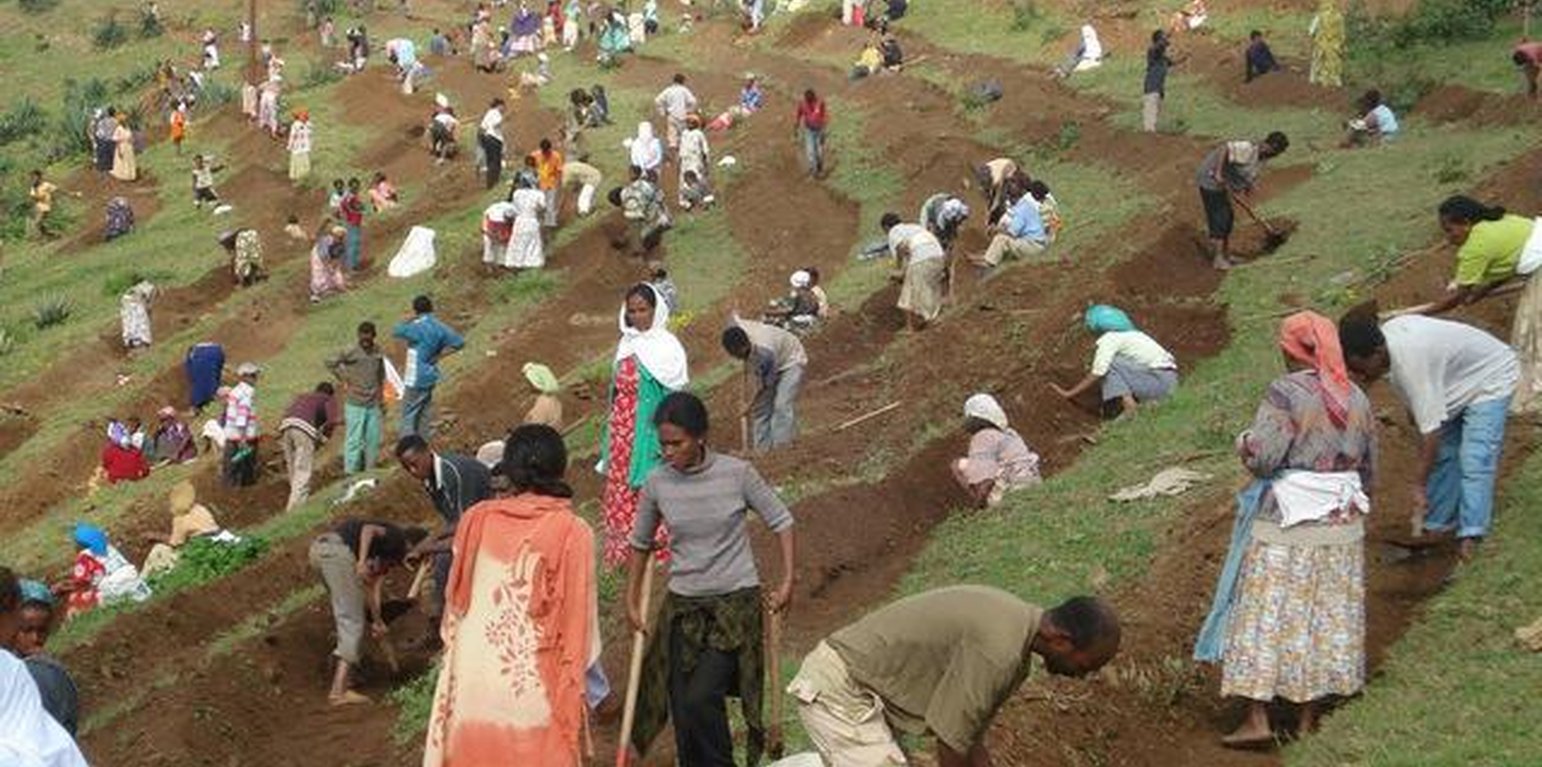Afforestation and Hillside Terracing
(厄立特里亚)
描述
Tree plantations in combination with hillside terracing to protect upper catchment areas are a widespread technology in the Central and Northern Highland Zone of Eritrea.
In the early 1990s a large area was treated in the Toker catchment, northwest of Asmara. The first step was to establish hillside terraces on the steeper slopes where it is essential to conserve soil and water for improved growth of trees and other vegetation. The terraces comprise earthen embankments laid out along the along the contour, reinforced with stone risers, combined with a trench on the upper side to harvest runoff water. The trenches are subdivided into basins (by ties) to avoid lateral flow of runoff water. In a second step, trees were planted at a spacing of 2 m (in the trenches). Mostly fast growing eucalyptus was used, with a very small percentage of the indigenous African olive (Olea africana) - which has good survival rates but grows very slowly. Afforested areas are closed for any use until the trees reach maturity: they are protected by guards. In 1995 the Ministry of Agriculture handed over user rights to communities allowing cut-and-carry of grass and cutting of trees (with permission of the government). The technology requires appreciable expense, labor and expertise, but if maintained well, it results in multiple ecological and economic benefits: Soil cover has improved, water is conserved, the severe problems of soil erosion have been reduced, and dams further downstream are protected from siltation. Trees have become an important source of income for the rural communities, wood is a valuable resource mainly needed for construction, and also as fuel. Since the 1960s, several afforestation campaigns have been initiated by the government, mainly using food-for-work or cash-for-work approaches as incentives. Nowadays, local tree planting initiatives (on community or individual level) without external support are dominant.
地点
![]()
地点: Serejeka, Central Highlands, 厄立特里亚
分析的技术场所数量:
技术传播: 均匀地分布在一个区域 (30.0 km²)
在永久保护区?:
实施日期: 10-50年前
介绍类型
-
通过土地使用者的创新
-
作为传统系统的一部分(> 50 年)
-
在实验/研究期间
-
通过项目/外部干预

An upper catchment area protected by hillside terraces and tree planting in the Central Highland of Eritrea (Mats Gurtner)
主要目的
-
改良生产
-
减少、预防、恢复土地退化
-
保护生态系统
-
结合其他技术保护流域/下游区域
-
保持/提高生物多样性
-
降低灾害风险
-
适应气候变化/极端天气及其影响
-
减缓气候变化及其影响
-
创造有益的经济影响
-
创造有益的社会影响
土地利用
-
森林/林地
Tree types: 桉树树种
产品和服务: 木材, 薪材, 放牧/啃牧
供水
土地退化相关的目的
-
防止土地退化
-
减少土地退化
-
修复/恢复严重退化的土地
-
适应土地退化
-
不适用
解决的退化问题
-
土壤水蚀 - Wt:表土流失/地表侵蚀 , Wg:冲沟侵蚀/沟蚀
-
生物性退化 - Bc:植被覆盖的减少, Bq:数量/生物量减少, Bs:质量和物种组成/多样性的下降
技术建立与维护:活动、投入和费用
投入和成本的计算
- 计算的成本为:
- 成本计算使用的货币:不适用
- 汇率(换算为美元):1 美元 = 不适用
- 雇用劳工的每日平均工资成本:不适用
影响成本的最重要因素
Labour cost includes construction of hillside terrace, pitting, planting and spot weeding and cultivation. According to the work and payment norms of the Ministry of Agriculture the cost of 1 person-day is 2.66 US$. Production cost of one seedling is 0.2 US$. Maintenance costs include terrace maintenance, re-pitting and replanting of seedlings.
技术建立活动
-
Dig planting pits (0.5 x 0.5x 0.5 m), at 2 m intervals, in the trenches (时间/频率: None)
-
Plant tree seedlings (mainly eucalypts, some African olives); fill pit with top soil (optional: mix with 1 spade of manure) (时间/频率: None)
-
Spot weeding and softening soil around the pits to improve percolation of water and soil aeration (during rainy season) (时间/频率: None)
-
Supplementary irrigation during dry spells (using jerry / watering cans) (时间/频率: None)
-
Prohibit open grazing: Area closure is done collectively (时间/频率: None)
-
Mark contour lines using a line level. Spacing between terraces depends on slope, vegetation status, soil depth. In the case study area horizontal spacing between terraces is 2.5 m (时间/频率: None)
-
Terraces are built (inward-sloping) by digging out trenches (0.5 m deep) and piling up risers (minimum 0.75 m high). Risers should be reinforced with stones (where available) (时间/频率: None)
-
The trenches are separated into basins by ties at an interval of 2-5 m to avoid eventual lateral movement of water (时间/频率: None)
技术建立的投入和成本
| 对投入进行具体说明 |
单位 |
数量 |
单位成本 (不适用) |
每项投入的总成本 (不适用) |
土地使用者承担的成本% |
|
劳动力
|
| Labour |
ha |
1.0 |
1760.0 |
1760.0 |
73.0 |
|
设备
|
| Tools |
ha |
1.0 |
50.0 |
50.0 |
73.0 |
|
植物材料
|
| Seedlings |
ha |
1.0 |
600.0 |
600.0 |
73.0 |
| 技术建立所需总成本 |
2'410.0 |
|
| 技术建立总成本,美元 |
2'410.0 |
|
技术维护活动
-
Replacement of missing plants at onset of rains (10% replacement of seedlings is expected in the 1st year) (时间/频率: onset of rains)
-
Spot weeding and softening soil (时间/频率: None)
-
Supplementary irrigation (时间/频率: None)
-
Maintenance of structures (时间/频率: before onset of rainy season)
技术维护的投入和成本
| 对投入进行具体说明 |
单位 |
数量 |
单位成本 (不适用) |
每项投入的总成本 (不适用) |
土地使用者承担的成本% |
|
劳动力
|
| Labour |
ha |
1.0 |
480.0 |
480.0 |
83.0 |
|
植物材料
|
| Seedlings |
ha |
1.0 |
100.0 |
100.0 |
83.0 |
| 技术维护所需总成本 |
580.0 |
|
| 技术维护总成本,美元 |
580.0 |
|
自然环境
年平均降雨量
-
< 250毫米
-
251-500毫米
-
501-750毫米
-
751-1,000毫米
-
1,001-1,500毫米
-
1,501-2,000毫米
-
2,001-3,000毫米
-
3,001-4,000毫米
-
> 4,000毫米
关于气候的规范
Thermal climate class: tropics
斜坡
-
水平(0-2%)
-
缓降(3-5%)
-
平缓(6-10%)
-
滚坡(11-15%)
-
崎岖(16-30%)
-
陡峭(31-60%)
-
非常陡峭(>60%)
海拔
-
0-100 m a.s.l.
-
101-500 m a.s.l.
-
501-1,000 m a.s.l.
-
1,001-1,500 m a.s.l.
-
1,501-2,000 m a.s.l.
-
2,001-2,500 m a.s.l.
-
2,501-3,000 m a.s.l.
-
3,001-4,000 m a.s.l.
-
> 4,000 m a.s.l.
土壤深度
-
非常浅(0-20厘米)
-
浅(21-50厘米)
-
中等深度(51-80厘米)
-
深(81-120厘米)
-
非常深(> 120厘米)
土壤质地(表土)
-
粗粒/轻(砂质)
-
中粒(壤土、粉土)
-
细粒/重质(粘土)
土壤质地(地表以下>20厘米)
-
粗粒/轻(砂质)
-
中粒(壤土、粉土)
-
细粒/重质(粘土)
水质(未处理)
-
良好饮用水
-
不良饮用水(需要处理)
-
仅供农业使用(灌溉)
-
不可用
应用该技术的土地使用者的特征
非农收入
-
低于全部收入的10%
-
收入的10-50%
-
> 收入的50%
个人或集体
-
个人/家庭
-
团体/社区
-
合作社
-
员工(公司、政府)
每户使用面积
-
< 0.5 公顷
-
0.5-1 公顷
-
1-2 公顷
-
2-5公顷
-
5-15公顷
-
15-50公顷
-
50-100公顷
-
100-500公顷
-
500-1,000公顷
-
1,000-10,000公顷
-
> 10,000公顷
土地所有权
-
州
-
公司
-
社区/村庄
-
团体
-
个人,未命名
-
个人,有命名
采用和适应
在所有采用这种技术的人当中,有多少人在没有获得物质奖励的情况下采用了这种技术?
-
0-10%
-
11-50%
-
51-90%
-
91-100%
最近是否对该技术进行了修改以适应不断变化的条件?
什么样的变化条件?
-
气候变化/极端气候
-
不断变化的市场
-
劳动力可用性(例如,由于迁移)
结论和吸取的教训
长处: 土地使用者的观点
长处: 编制者或其他关键资源人员的观点
-
Protection of slopes from erosion while at the same time providing an income source for the poor
弱点/缺点/风险: 土地使用者的观点如何克服
-
Establishment cost is high and labour intensiv
provision of hand tools and demanded seedlings
-
Fast growing eucalyptus trees have a high rate of water consumption; Indigenous trees are not favoured
encourage people to protect naturally regenerated indigenous trees, assist villagers to get market channels for products of indigenous trees
-
Community mobilization and high knowledge of land users is required
awareness raising campaigns, strengthen village institutional arrangements, assist villages bylaws
-
Land use rights: because the afforestation area is communal, nobody feels responsible for maintenance
promote plantations by individual households
弱点/缺点/风险: 编制者或其他关键资源人员的观点如何克服
参考文献
审查者
-
Fabian Ottiger
-
Alexandra Gavilano
实施日期: Nov. 15, 2010
上次更新: March 27, 2019
资源人
-
Eyob Zeremariam - SLM专业人员
-
Tsehaye Bereket - SLM专业人员
文件编制者
机构
- Ministry of Agriculture of Eritrea (MoA) - 厄立特里亚
- Toker Integrated Community Development - 厄立特里亚
项目
- Book project: SLM in Practice - Guidelines and Best Practices for Sub-Saharan Africa (SLM in Practice)
主要参考文献
-
Zeremariam I. 2001. Assessment of upper catchment development technologies in the Central High Land zone of Eritrea. MSc Thesis; The Royal Veterinary and Agricultural University, Denmark.:
-
Amanuel Negasi et al. 2002. Soil and water conservation Manual for Eritrea. RELMA.:
-
Zeremariam I.2001. Assessment of upper catchment Development Technologies and Approaches in the Central High Land zone of Eritrea. MSc Thesis; The Royal Veterinary and Agricultural University, Denmark:











